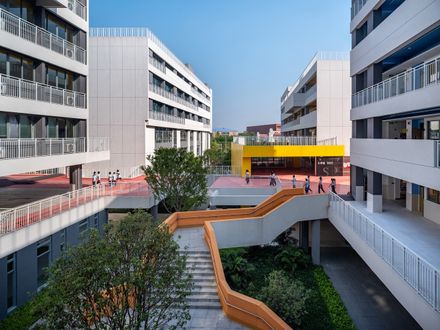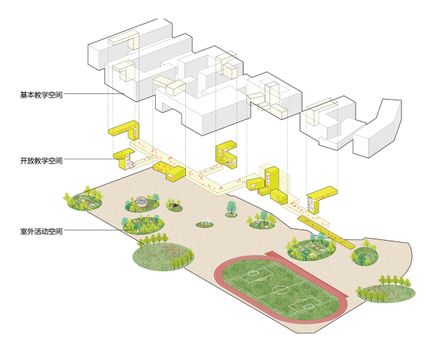
Foshan Meisha Bilingual School
FOSHAN MEISHA BILINGUAL SCHOOL
AUBE CONCEPTION
LOCATION
Foshan, China
CATEGORY
Elementary & Middle School
PHOTOGRAPHS
Fangfang Tian
CLIENT
Foshan Vanke Properties Development Co., Ltd.
DEVELOPER
Foshan Nanhai Shishan Meisha Education Development Co., Ltd.
INTERIOR DESIGN
Shenzhen 9du Interior Design Co., Ltd.
LANDSCAPE DESIGN
Gnd Design Limited
CONSTRUCTION DRAWINGS
Guangdong Qiyuan Construction Engineering Design Institute Co., Ltd.
Text description provided by architect.
Located on the waterfront of Xianxi Reservoir in Nanshan District, Foshan, Foshan Meisha Bilingual School is adjacent to the Nanshan University Town next to the Foshan University of Science and Technology.
This 9-year system boarding school established by Vanke Meisha Education with great efforts covers an area of approximately 62,000m2, running 72 elementary school classes and 36 middle school classes.
In the context of building a first-class modern school with excellence that requires integrating the essence of Chinese and Western cultures while promoting the reformation of education methods and learning spaces, AUBE Conception puts forward the design concept of a "Playground Community" that interlinks various functional spaces of "study, accommodation, canteen, leisure and play" to have the school evolve from simply a teaching place into a playground of diverse experiences, creating a composite learning-living place for edutainment.
The major difference between a boarding school and an ordinary one is that the former not only undertakes its teaching functions but is also a place where students will live 24 hours a day. As most of the student will be living and studying on this campus for 9 years, a richer spatial experience and a more comfortable environment for activities are particularly essential.
The campus sits on an irregular rectangle site in the north-south direction with the track and field venues on its northeast corner whilst the teaching buildings concentrate on the south side.
The school layout adopts the spatial arrangements of "shared union", "small courtyards within a big garden" and "scenario integration"; meanwhile, by avoiding the axially symmetrical pattern often applied in traditional campus design, it forms a Chinese garden imagery of "small courtyards within a big garden" in a linear series, and a free and open space is thus shaped to match the future education notions.
The main buildings are north-south oriented, and the frequently used facilities including library, lecture hall, gym and canteen are interspersed with each individual one on the bottom level to offer multi-layered outdoor activity venues, covered by conventional classrooms located on level two to level five.
The multi-themed settlement-type learning-sharing spaces are provided by courtyards to encourage student to conduct active exploration, and the semi-enclosed courtyard forms a visually open corridor, enriching the visions with "scenario integration".
The "shared corridor" interconnects the "vitality cores" to set up a campus roaming system, which links the entire school from the bottom to rooftops through roof platforms and courtyards of all scales. The "vitality cores" in varied shapes and spatial arrangements are embedded into basic functional spaces, breaking the boundary of indoor and outdoor spaces as activation points.
As the principal circulation space in the campus, the "shared corridor" also organically connects the classrooms, living spaces, sports venues and landscaped greenery to construct a multi-leveled, all-around and three-dimensional place for events accompanied by social and informal teaching spaces with rich spatial experiences to stimulate the vitality on campus.
The students will be cultivated through experiential explorations offered by the classroom break-time activity terraces, pergola lounge, star-gazing deck, rooftop farm, leisure spaces and rooftop basketball courts; in the meantime, the art box, outdoor podium, open-air theater and publicity walls will enhance the diverse enjoyment of social spaces.
Each courtyard has its own character matching the nature and educational needs of all age groups, so that students will enjoy rich and colorful memories during the 9 long years of campus life.
Foshan is located in the subtropical area with a hot and rainy climate. The campus design draws on passive strategies celebrated in traditional Lingnan gardens in terms of ventilation, insulation, rainproof and moisture protection with the help of spatial forms including "cold lanes", "patios", "open halls" and "courtyards" to achieve climatic adaptation as well as responding to its regional context.
The architectural layout is planned at an angle of 15-25 degrees with the dominant summer wind in Foshan to ensure good ventilation conditions for the middle school teaching buildings and science building downwind. .
On the other hand, the upwind elementary school teaching buildings and the art building manage to ventilate the classrooms by partially elevating the structure, forming ground-floor corridors with devised open halls to utilize the wind pressure principles
The ventilation sequence of the science building structure is composed of patios, open halls, loggias and elevated floors, and natural ventilation is achieved through open spaces of different scales complemented by skylights with favorable ventilation properties.
The gray spaces formed by overhanging eaves, elevated floors and arcades can cope with the strong sunlight in southern China, keeping the wind and rain away to create a pleasant space for activities.
Educational concepts and teaching methods have undergone changes through the ages with time. Nowadays, the traditional monotonous and mode-fixed teaching spaces will no longer satisfy the diversified teaching models and education notions of cultivating all-round talents.
The school shall not be a "cage" of repressed nature, but a "paradise" for students to study and develop, and educational architecture should also answer to the constantly updating teaching concepts and methods.
Apart from undertaking the modern educational functions with its "playground community" of openness, sharing and sophisticated spatial arrangements, Foshan Meisha Bilingual School also sets up a lively and vibrant amusement park for children.




















